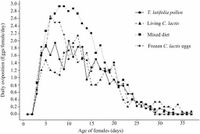In a significant advancement for biological pest control, researchers have optimized the diet of the predatory mite Transeius montdorensis, enhancing its effectiveness as a biological control agent against common agricultural pests such as thrips and whiteflies. The findings were published recently, highlighting how a combination of cattail pollen and frozen eggs of the dried fruit mite Carpoglyphus lactis leads to improved reproduction and development rates in T. montdorensis.
Traditionally, predatory mites have been a crucial part of Integrated Pest Management (IPM) strategies, offering an environmentally friendly alternative to chemical pesticides. The study assessed four different diets to determine which would best support the growth and reproduction of T. montdorensis under controlled laboratory conditions. The diets evaluated included cattail pollen, living C. lactis, frozen C. lactis eggs, and a mixed diet comprising frozen eggs and cattail pollen.
Notably, the predatory mites fed on the mixed diet exhibited the highest levels of fecundity, daily oviposition rates, and intrinsic rates of increase compared to those on other diets. In fact, females consuming the mixed diet provided significant advantages, resulting in the shortest immature development period and the highest net reproductive rate (R0). In contrast, those reared solely on living C. lactis took the longest to mature and demonstrated the lowest reproductive success.
Ultimately, the incorporation of frozen C. lactis eggs and cattail pollen not only accelerates the development of T. montdorensis but also reduces the risks related to mite infestations generated by using live prey. This factor is significant as living C. lactis can sometimes prey on the larvae and eggs of T. montdorensis, introducing considerable risks for laboratory rearing and field application.
The study, spearheaded by researchers from the Australian Department of Agriculture, was conducted under rigorously controlled conditions, with temperatures maintained at a steady 25 ± 1 °C and high humidity to simulate optimal growing environments for these mites. The team meticulously documented developmental times, oviposition periods, and survival rates across all four dietary treatments.
The authors noted: "The females on a mixed diet showed the shortest immature development time compared to other diets.” Analyzing the data revealed that females on mixed diets laid nearly double the amount of eggs compared to those strictly reliant on living C. lactis.
This research not only enhances the understanding of T. montdorensis but also showcases the potential of integrating non-living diets, like frozen eggs, into routine agricultural practices to maintain predator populations, especially during periods when natural prey may be scarce.
Furthermore, the use of cattail pollen (collected fresh in December 2022) as an alternative food source is particularly promising. It is cost-effective and easily accessible, adding to its appeal as a staple in mass-rearing formulations for Transeius montdorensis and possibly other predatory mite species.
Moving forward, the next steps involve evaluating the effectiveness of this mixed diet in larger scale applications and determining its efficacy in different environmental conditions. As global agricultural practices continue to grapple with pest management challenges, optimizing biological control agents like T. montdorensis through dietary adjustments could significantly reduce reliance on harmful pesticides and lead to more sustainable farming practices.

